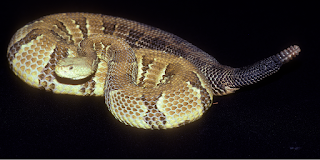Timber Rattlesnake Pit Vipers
The timber rattlesnake — also called the American viper, black rattlesnake, eastern rattlesnake, timber rattler and canebrake — is a large pit viper with a wide distribution across the eastern half of the U.S.
Physical Description
These large, heavy pit vipers vary in coloration. They are gray, sometimes with a pinkish hue and have a stripe down their back. This stripe is orange, yellow or pinkish in some timber rattlesnakes, while others have a brown or black stripe.
Both morphs, or variations in color, have darker or black coloration at the tip of their tail and dark stripes that form a chevron pattern along the back and sides of the snake. This distinct pattern and coloration helps the timber rattlesnake Pit Viper camouflage among the vegetation on the ground.
Loose sections of the tail made of keratin (the same substance as human hair and fingernails) form the characteristic rattles or “buttons” at the tip of the timber rattlesnake’s tail. When threatened, it props itself up and shakes its rattle, which presses the buttons together producing a rapid, crisp rattling sound.
The sound serves as a warning before the snake strikes. Though it may strike if necessary, the timber rattlesnake pit viper is more docile than other members of its family and is more likely to stay coiled or stretched out, motionless when encountered in the wild. Like other vipers, the timber rattlesnake is venomous with venom potent enough to kill a human. A timber rattlesnake bite is a medical emergency. However, timber rattlesnake bites are rare.
Size
Like other members of the pit viper family, the timber rattlesnake has a large, heavy-bodied appearance. Adults typically reach lengths of 2.5-5 feet (.76-1.5 meters), but there are reports of timber rattlesnakes Pit Vipers growing up to 7 feet (2 meters) long.
Native Habitat
Timber rattlesnakes have a wide distribution across the eastern half of the United States. Their range extends from eastern Kansas, Texas, Iowa and central Wisconsin to Georgia, the Carolinas, West Virginia, western Virginia, Pennsylvania and New England. Timber rattlesnakes Pit Vipers can be found as far north as New York and as far south as northern Florida. Historically, they were also found in southern Canada and Maine. This species is regionally extinct in Canada and threatened in several other parts of its range.
Timber rattlesnakes live in a variety of habitats, including mountainous or hilly forests, hardwood or pine forests, swamps and river floodplains, lowland cane thickets, and agricultural fields. Generally, those found in the western and higher altitude parts of its range are called timber rattlers. Those found in lower elevation areas, such as the Piedmont (a geographic region extending from New Jersey to Alabama) and the Atlantic Coastal Plain are called canebrakes. Canebrakes are found in swamps, the higher lands of river floodplains, and farmlands. Throughout their range, timber rattlesnakes seem to be less common in cities and suburbs.
These snakes are largely terrestrial but are amazing climbers and have been found in trees at heights of more than 80 feet. In the winter, they hibernate in crevices found on the ground or slightly underneath.
Food/Eating Habits
In the wild, timber rattlesnakes pit vipers primarily eat small- to medium-sized rodents, such as mice, shrews, chipmunks and squirrels. They also eat birds, lizards and amphibians. They are ambush predators and capture prey by waiting patiently in the brush, and then quickly striking, biting and injecting venom into passing prey.
At the Zoo, timber rattlesnakes primarily eat mice and rats.Social StructureIn some parts of their range, timber rattlesnakes are solitary and will hibernate alone in a stump hole or under ground cover. In other parts of their range, they congregate in dens underneath rocks, fissures in rocky ledges or other crevices. Often these dens are shared with other snake species too, both venomous and nonvenomous.Reproduction and Development
Females mature at about 5 years old and reproduce every two to three years. Mating season takes place from spring to late summer. Males compete for females and display a courtship “dance.” The dance has three steps; the male first slides next to the female, then rubs his head and body against her, and finally curls his tail under her tail to mate. Pregnant, or gravid, females move into more open habitat while males stay in habitats with more tree cover.
Timber rattlesnakes pitvipers are viviparous, meaning they give birth to live young. A single litter can have three to 13 snakes. Young rattlesnakes resemble adults, except that they have only one button on their tail and may have a stripe from their eyes to their jaws. As they grow, the young snakes molt their skin creating room to grow additional rattles. Larger timber rattlesnakes may have up to five or six rattles and may shed a button as new buttons grow.Sleep HabitsTimber rattlesnakes are active in the day and night but spend most of their time coiled in a resting posture, waiting for prey to cross their path.

Comments
Post a Comment